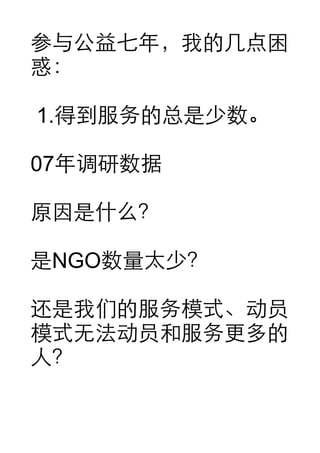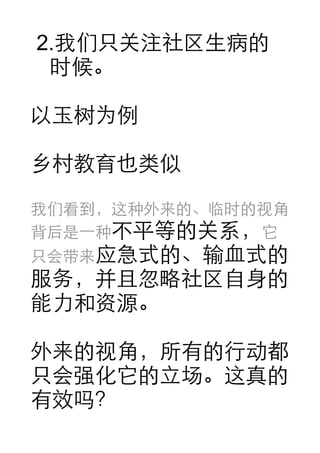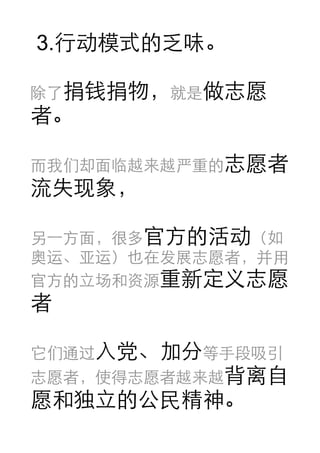公益反思110311
0 likes469 views
An NGO works with local communities to provide education and job training. It focuses on empowering women and youth who face barriers. The organization aims to give opportunities to help improve lives through community programs and partnerships.
1 of 8
Download to read offline








Ad
Recommended
微公益──普通人的行动如何改变世界?
微公益──普通人的行动如何改变世界?Andrew Yu
?
1. Wikipedia has over 3 million articles contributed by around 98,000 editors with over 400 language editions. It has seen steady growth rates of around 3-3% annually since 2003.
2. The document discusses the history and growth of Wikipedia from its start in 2001 to 2009. It notes key milestones like reaching over 100 articles by the end of 2001 and over 1,000 by January 2002.
3. The author's Twitter usage is also summarized, noting he started using the platform in November 2009 and uses hashtags like #pylj to discuss topics like Python and learning journals.I Space计划(公开版)
I Space计划(公开版)Andrew Yu
?
i-Space is a company that launched in 2009 and saw revenue grow from $2 million in 2011 to $20 million by 2015, with 38% of revenue coming from internet services and 31% from creative services. The company aims to continue growing revenue to $15-20 million annually by expanding their internet and imagination-focused services to new markets between 500-1000 potential customers each quarter.Social Tv. Una sfida per la Pa - 10 ottobre 2013
Social Tv. Una sfida per la Pa - 10 ottobre 2013andrea casalegno
?
Il documento discute la differenza tra un sistema complicato e uno complesso, utilizzando la metafora di ricostruire un aereo. Si sottolinea come i sistemi complessi emergano dalle interazioni degli elementi e siano difficili da controllare. Inoltre, viene evidenziato il cambiamento degli sistemi tecnologici e sociali nel tempo.多背一公斤09工作总结
多背一公斤09工作总结Andrew Yu
?
This document appears to be a report containing statistics and facts from 2009. It includes percentages showing increases from 2008 to 2009 in categories like GeekCook visitors and articles. It also lists over 30 news stories or events from 2009 with brief descriptions, many relating to technology, education or media in China. The document provides an overview of statistics and major news items from China in the year 2009.1Kg Postcasd Intro.
1Kg Postcasd Intro.Andrew Yu
?
该文档讲述了一个公益贺卡项目的故事,旨在通过设计贺卡为书籍筹资,推动公益参与和服务的可持续性。项目强调自我造血和市场化运作,其目标是服务100-300所学校并增强参与者的体验。文档还探讨了如何通过透明流程和互动联系增强公众参与感。公益反思110311
公益反思110311Andrew Yu
?
This document discusses poverty statistics in China from 2003 to 2008. It notes that the number of people living below the poverty line decreased from 42.6 million in 2003 to 30 million in 2008, with the poverty rate falling from 4% to 3% in rural areas. It also provides operational figures for poverty alleviation programs, noting that over 18,000 people received support in total. The document encourages sharing photos related to poverty online and using social media to spread awareness.多背一公斤09工作总结
多背一公斤09工作总结Andrew Yu
?
This document appears to be a report containing statistics and metrics for the years 2008 and 2009. It includes metrics such as sales numbers that increased by 49%, 193%, and 309% from 2008 to 2009. It also lists over 30 news articles or reports from various sources published between 2009/12/30 to 2009/1/5 discussing topics like education initiatives in rural China, new television programs, and corporate partnerships.我们为什么做爱聚
我们为什么做爱聚Andrew Yu
?
This document discusses iGeey, a company founded in 2009 that provides cloud computing services including data storage, backup, and sharing. The company has grown to over 1 million users since its founding and now has over 50 employees across offices in China and Singapore. iGeey offers both free and paid cloud storage and sharing plans to help individuals and businesses store and access their files from any internet-connected device.创新经验分享@NPI 20130315
创新经验分享@NPI 20130315Andrew Yu
?
文档讨论了社会创新的定义和实践,其中强调创新不仅仅是新想法,而是被社区采纳的新实践。通过实际案例和测试流程,展示了如何有效学习和实施创新。文档还提到有效的创新实践需要快速建立原型和不断测试的过程。乡村学校需要什么
乡村学校需要什么Andrew Yu
?
乡村学校面临硬件不足与师资短缺的问题,尽管硬件捐助占公益参与的90%。对素质教育和课外活动的需求日益增加,但当前的慈善方式缺乏创新和协作。建议通过开放合作与支持研究,为乡村教育的改善提供有效的解决方案。一公斤盒子项目介绍
一公斤盒子项目介绍Andrew Yu
?
1. Wang Jian founded the website 1KG in 2004 with the goal of using the internet and social media to help those in need.
2. Through 1KG, people can donate unused items which are then collected and distributed to those who need them for free. Over 500,000 items were donated in the first 4 years, and the site won awards for social innovation.
3. By 2011, 1KG had collected over 1.2 million items and helped over 70,000 families, diverting over 40% of items from landfills. The site continues growing and helping more people in need each year.多背一公斤的互联网公益实践110923
多背一公斤的互联网公益实践110923Andrew Yu
?
The document contains statistics from 2003, 2006, and 2008 as well as information about an organization called iGeey. iGeey has hosted over 1200 events attended by over 580 speakers and reached over 6000 people. It also lists viewing statistics for 7 videos with views ranging from hundreds to thousands.一公斤盒子项目介绍
一公斤盒子项目介绍Andrew Yu
?
The document outlines the history of iGeey starting in 2004 and its growth over the years. It discusses iGeey launching its first product in 2008, expanding to 1200 employees by 2009, and developing 3 main products by focusing on quality and customer satisfaction according to its philosophy that simplicity yields success.微型志工
微型志工Andrew Yu
?
The document discusses how a nonprofit organization called iGeey has grown from a small outsider group to a larger established organization over time. It started with only a few people in 2008 but has since expanded to over 800 volunteers. The organization began using online tools like Twitter and Slacktivism to raise awareness and engage more people. They later redesigned their website and processes to be more effective.微公益──普通人的行动如何改变世界?100428
微公益──普通人的行动如何改变世界?100428Andrew Yu
?
This document summarizes key statistics about Wikipedia and Twitter, including:
- Wikipedia has over 3 million articles contributed by over 98,000 editors with over 400 new articles per day. Growth rates have declined to under 4% for articles and 3% for editors.
- Twitter was launched in 2006 and had over 140 million tweets by 2009 from over 100,000 followers of Andrew's account, where he tweeted about topics like Python.
- 1KG.org was launched in 2008 and now has over 900 registered users who have made over 800 knowledge gifts totaling over 100,000 words of content across 10 categories.1碍骋.辞谤驳网站产物设计
1碍骋.辞谤驳网站产物设计Andrew Yu
?
The document appears to be a report from an NGO organization listing various statistics including numbers of people served and amounts of resources distributed across multiple categories. Tables include columns for items like number of people, amounts of resources, dates, and locations. Photos are also referenced throughout.2010年的多背一公斤Andrew Yu
?
Le document présente des données financières sur plusieurs années, indiquant une croissance significative entre 2008 et 2010. Les chiffres montrent des augmentations de 49%, 193% et 309% sur différentes catégories. Les détails spécifiques sur les catégories ne sont pas fournis.公益创业分享 Andrew 1 Kg 100115
公益创业分享 Andrew 1 Kg 100115Andrew Yu
?
公益创业五部曲包括发现社会问题、提出创新方法、快速行动并测试调整、规模化以及保持耐心。文档提到农村儿童和乡村旅行者的数据,强调信息组织与流程的重要性。以800多所农村学校和每月30多项活动为例,展示了该方法的实施效果。专业与合作 Ngo的战略选择
专业与合作 Ngo的战略选择Andrew Yu
?
文档探讨了专业与合作 NGO 的战略选择,强调资金、服务及募捐的重要性。提出通过提升自身专业能力和建立广泛合作网络来增强影响力。主要关注公益社区和社区运营的合作模式。多背一公斤的互联网实践Andrew Yu
?
Le document fournit une série de données statistiques et numériques non structurées. Il semble faire référence à un site web ou une plateforme spécifique, 1kg.org, mais manque de contexte clair. Les informations sont principalement numériques sans explication fournie.贰虫肠苍肠图书室项目报告
贰虫肠苍肠图书室项目报告Andrew Yu
?
本文介绍了四川灾区学校建设图书室的计划,旨在为学生提供丰富的课外书籍,帮助他们获得更多的知识。计划涵盖10所学校,提供1000-1500册优质儿童读物、书架及管理工具,并包含详细的建设流程和学校反馈。通过志愿者的努力,成功于2009年完成图书室的建设与物资配送。多背一公斤知道什么091116
多背一公斤知道什么091116Andrew Yu
?
该文档详细列出了中国乡村学校面临的教育资源短缺情况和具体需求,包括教学设施、文具、运动器材以及师资力量等。迄今为止,已有800多所乡村学校受益于该项目,帮助了1300多名儿童满足基本教育需要。文档强调了对有效教育资源和师资的迫切需求,以改善乡村教育的整体状况。1Kg Postcasd Introduction
1Kg Postcasd IntroductionAndrew Yu
?
该文档讲述了四川的公益贺卡项目,旨在通过售卖贺卡以资助图书室建设,涉及可持续运营及社区参与。项目设计包括捐赠功能,让消费者能够选择支持的学校和跟踪捐赠成果。目标是支持100-300所学校,提高公众参与和公益体验。Presentation On Prix Ars Electronica 08 Forum
Presentation On Prix Ars Electronica 08 ForumAndrew Yu
?
The document discusses digital communities and rural schools. It mentions that there are 400,000 rural schools and 300 million rural travelers. The document suggests sharing community resources and allowing free linking as potential solutions.Creating Inclusive Digital Learning with AI: A Smarter, Fairer Future
Creating Inclusive Digital Learning with AI: A Smarter, Fairer FutureImpelsys Inc.
?
Have you ever struggled to read a tiny label on a medicine box or tried to navigate a confusing website? Now imagine if every learning experience felt that way—every single day.
For millions of people living with disabilities, poorly designed content isn’t just frustrating. It’s a barrier to growth. Inclusive learning is about fixing that. And today, AI is helping us build digital learning that’s smarter, kinder, and accessible to everyone.
Accessible learning increases engagement, retention, performance, and inclusivity for everyone. Inclusive design is simply better design.Integration of Utility Data into 3D BIM Models Using a 3D Solids Modeling Wor...
Integration of Utility Data into 3D BIM Models Using a 3D Solids Modeling Wor...Safe Software
?
Jacobs has developed a 3D utility solids modelling workflow to improve the integration of utility data into 3D Building Information Modeling (BIM) environments. This workflow, a collaborative effort between the New Zealand Geospatial Team and the Australian Data Capture Team, employs FME to convert 2D utility data into detailed 3D representations, supporting enhanced spatial analysis and clash detection.
To enable the automation of this process, Jacobs has also developed a survey data standard that standardizes the capture of existing utilities. This standard ensures consistency in data collection, forming the foundation for the subsequent automated validation and modelling steps. The workflow begins with the acquisition of utility survey data, including attributes such as location, depth, diameter, and material of utility assets like pipes and manholes. This data is validated through a custom-built tool that ensures completeness and logical consistency, including checks for proper connectivity between network components. Following validation, the data is processed using an automated modelling tool to generate 3D solids from 2D geometric representations. These solids are then integrated into BIM models to facilitate compatibility with 3D workflows and enable detailed spatial analyses.
The workflow contributes to improved spatial understanding by visualizing the relationships between utilities and other infrastructure elements. The automation of validation and modeling processes ensures consistent and accurate outputs, minimizing errors and increasing workflow efficiency.
This methodology highlights the application of FME in addressing challenges associated with geospatial data transformation and demonstrates its utility in enhancing data integration within BIM frameworks. By enabling accurate 3D representation of utility networks, the workflow supports improved design collaboration and decision-making in complex infrastructure projectsMore Related Content
More from Andrew Yu (20)
创新经验分享@NPI 20130315
创新经验分享@NPI 20130315Andrew Yu
?
文档讨论了社会创新的定义和实践,其中强调创新不仅仅是新想法,而是被社区采纳的新实践。通过实际案例和测试流程,展示了如何有效学习和实施创新。文档还提到有效的创新实践需要快速建立原型和不断测试的过程。乡村学校需要什么
乡村学校需要什么Andrew Yu
?
乡村学校面临硬件不足与师资短缺的问题,尽管硬件捐助占公益参与的90%。对素质教育和课外活动的需求日益增加,但当前的慈善方式缺乏创新和协作。建议通过开放合作与支持研究,为乡村教育的改善提供有效的解决方案。一公斤盒子项目介绍
一公斤盒子项目介绍Andrew Yu
?
1. Wang Jian founded the website 1KG in 2004 with the goal of using the internet and social media to help those in need.
2. Through 1KG, people can donate unused items which are then collected and distributed to those who need them for free. Over 500,000 items were donated in the first 4 years, and the site won awards for social innovation.
3. By 2011, 1KG had collected over 1.2 million items and helped over 70,000 families, diverting over 40% of items from landfills. The site continues growing and helping more people in need each year.多背一公斤的互联网公益实践110923
多背一公斤的互联网公益实践110923Andrew Yu
?
The document contains statistics from 2003, 2006, and 2008 as well as information about an organization called iGeey. iGeey has hosted over 1200 events attended by over 580 speakers and reached over 6000 people. It also lists viewing statistics for 7 videos with views ranging from hundreds to thousands.一公斤盒子项目介绍
一公斤盒子项目介绍Andrew Yu
?
The document outlines the history of iGeey starting in 2004 and its growth over the years. It discusses iGeey launching its first product in 2008, expanding to 1200 employees by 2009, and developing 3 main products by focusing on quality and customer satisfaction according to its philosophy that simplicity yields success.微型志工
微型志工Andrew Yu
?
The document discusses how a nonprofit organization called iGeey has grown from a small outsider group to a larger established organization over time. It started with only a few people in 2008 but has since expanded to over 800 volunteers. The organization began using online tools like Twitter and Slacktivism to raise awareness and engage more people. They later redesigned their website and processes to be more effective.微公益──普通人的行动如何改变世界?100428
微公益──普通人的行动如何改变世界?100428Andrew Yu
?
This document summarizes key statistics about Wikipedia and Twitter, including:
- Wikipedia has over 3 million articles contributed by over 98,000 editors with over 400 new articles per day. Growth rates have declined to under 4% for articles and 3% for editors.
- Twitter was launched in 2006 and had over 140 million tweets by 2009 from over 100,000 followers of Andrew's account, where he tweeted about topics like Python.
- 1KG.org was launched in 2008 and now has over 900 registered users who have made over 800 knowledge gifts totaling over 100,000 words of content across 10 categories.1碍骋.辞谤驳网站产物设计
1碍骋.辞谤驳网站产物设计Andrew Yu
?
The document appears to be a report from an NGO organization listing various statistics including numbers of people served and amounts of resources distributed across multiple categories. Tables include columns for items like number of people, amounts of resources, dates, and locations. Photos are also referenced throughout.2010年的多背一公斤Andrew Yu
?
Le document présente des données financières sur plusieurs années, indiquant une croissance significative entre 2008 et 2010. Les chiffres montrent des augmentations de 49%, 193% et 309% sur différentes catégories. Les détails spécifiques sur les catégories ne sont pas fournis.公益创业分享 Andrew 1 Kg 100115
公益创业分享 Andrew 1 Kg 100115Andrew Yu
?
公益创业五部曲包括发现社会问题、提出创新方法、快速行动并测试调整、规模化以及保持耐心。文档提到农村儿童和乡村旅行者的数据,强调信息组织与流程的重要性。以800多所农村学校和每月30多项活动为例,展示了该方法的实施效果。专业与合作 Ngo的战略选择
专业与合作 Ngo的战略选择Andrew Yu
?
文档探讨了专业与合作 NGO 的战略选择,强调资金、服务及募捐的重要性。提出通过提升自身专业能力和建立广泛合作网络来增强影响力。主要关注公益社区和社区运营的合作模式。多背一公斤的互联网实践Andrew Yu
?
Le document fournit une série de données statistiques et numériques non structurées. Il semble faire référence à un site web ou une plateforme spécifique, 1kg.org, mais manque de contexte clair. Les informations sont principalement numériques sans explication fournie.贰虫肠苍肠图书室项目报告
贰虫肠苍肠图书室项目报告Andrew Yu
?
本文介绍了四川灾区学校建设图书室的计划,旨在为学生提供丰富的课外书籍,帮助他们获得更多的知识。计划涵盖10所学校,提供1000-1500册优质儿童读物、书架及管理工具,并包含详细的建设流程和学校反馈。通过志愿者的努力,成功于2009年完成图书室的建设与物资配送。多背一公斤知道什么091116
多背一公斤知道什么091116Andrew Yu
?
该文档详细列出了中国乡村学校面临的教育资源短缺情况和具体需求,包括教学设施、文具、运动器材以及师资力量等。迄今为止,已有800多所乡村学校受益于该项目,帮助了1300多名儿童满足基本教育需要。文档强调了对有效教育资源和师资的迫切需求,以改善乡村教育的整体状况。1Kg Postcasd Introduction
1Kg Postcasd IntroductionAndrew Yu
?
该文档讲述了四川的公益贺卡项目,旨在通过售卖贺卡以资助图书室建设,涉及可持续运营及社区参与。项目设计包括捐赠功能,让消费者能够选择支持的学校和跟踪捐赠成果。目标是支持100-300所学校,提高公众参与和公益体验。Presentation On Prix Ars Electronica 08 Forum
Presentation On Prix Ars Electronica 08 ForumAndrew Yu
?
The document discusses digital communities and rural schools. It mentions that there are 400,000 rural schools and 300 million rural travelers. The document suggests sharing community resources and allowing free linking as potential solutions.Recently uploaded (20)
Creating Inclusive Digital Learning with AI: A Smarter, Fairer Future
Creating Inclusive Digital Learning with AI: A Smarter, Fairer FutureImpelsys Inc.
?
Have you ever struggled to read a tiny label on a medicine box or tried to navigate a confusing website? Now imagine if every learning experience felt that way—every single day.
For millions of people living with disabilities, poorly designed content isn’t just frustrating. It’s a barrier to growth. Inclusive learning is about fixing that. And today, AI is helping us build digital learning that’s smarter, kinder, and accessible to everyone.
Accessible learning increases engagement, retention, performance, and inclusivity for everyone. Inclusive design is simply better design.Integration of Utility Data into 3D BIM Models Using a 3D Solids Modeling Wor...
Integration of Utility Data into 3D BIM Models Using a 3D Solids Modeling Wor...Safe Software
?
Jacobs has developed a 3D utility solids modelling workflow to improve the integration of utility data into 3D Building Information Modeling (BIM) environments. This workflow, a collaborative effort between the New Zealand Geospatial Team and the Australian Data Capture Team, employs FME to convert 2D utility data into detailed 3D representations, supporting enhanced spatial analysis and clash detection.
To enable the automation of this process, Jacobs has also developed a survey data standard that standardizes the capture of existing utilities. This standard ensures consistency in data collection, forming the foundation for the subsequent automated validation and modelling steps. The workflow begins with the acquisition of utility survey data, including attributes such as location, depth, diameter, and material of utility assets like pipes and manholes. This data is validated through a custom-built tool that ensures completeness and logical consistency, including checks for proper connectivity between network components. Following validation, the data is processed using an automated modelling tool to generate 3D solids from 2D geometric representations. These solids are then integrated into BIM models to facilitate compatibility with 3D workflows and enable detailed spatial analyses.
The workflow contributes to improved spatial understanding by visualizing the relationships between utilities and other infrastructure elements. The automation of validation and modeling processes ensures consistent and accurate outputs, minimizing errors and increasing workflow efficiency.
This methodology highlights the application of FME in addressing challenges associated with geospatial data transformation and demonstrates its utility in enhancing data integration within BIM frameworks. By enabling accurate 3D representation of utility networks, the workflow supports improved design collaboration and decision-making in complex infrastructure projectsViral>Wondershare Filmora 14.5.18.12900 Crack Free Download
Viral>Wondershare Filmora 14.5.18.12900 Crack Free DownloadPuppy jhon
?
? ???COPY & PASTE LINK??? ? ?? https://drfiles.net/
Wondershare Filmora Crack is a user-friendly video editing software designed for both beginners and experienced users.
TrustArc Webinar - 2025 Global Privacy Survey
TrustArc Webinar - 2025 Global Privacy SurveyTrustArc
?
How does your privacy program compare to your peers? What challenges are privacy teams tackling and prioritizing in 2025?
In the sixth annual Global Privacy Benchmarks Survey, we asked global privacy professionals and business executives to share their perspectives on privacy inside and outside their organizations. The annual report provides a 360-degree view of various industries' priorities, attitudes, and trends. See how organizational priorities and strategic approaches to data security and privacy are evolving around the globe.
This webinar features an expert panel discussion and data-driven insights to help you navigate the shifting privacy landscape. Whether you are a privacy officer, legal professional, compliance specialist, or security expert, this session will provide actionable takeaways to strengthen your privacy strategy.
This webinar will review:
- The emerging trends in data protection, compliance, and risk
- The top challenges for privacy leaders, practitioners, and organizations in 2025
- The impact of evolving regulations and the crossroads with new technology, like AI
Predictions for the future of privacy in 2025 and beyondProviding an OGC API Processes REST Interface for FME Flow
Providing an OGC API Processes REST Interface for FME FlowSafe Software
?
This presentation will showcase an adapter for FME Flow that provides REST endpoints for FME Workspaces following the OGC API Processes specification. The implementation delivers robust, user-friendly API endpoints, including standardized methods for parameter provision. Additionally, it enhances security and user management by supporting OAuth2 authentication. Join us to discover how these advancements can elevate your enterprise integration workflows and ensure seamless, secure interactions with FME Flow.“Why It’s Critical to Have an Integrated Development Methodology for Edge AI,...
“Why It’s Critical to Have an Integrated Development Methodology for Edge AI,...Edge AI and Vision Alliance
?
For the full video of this presentation, please visit: https://www.edge-ai-vision.com/2025/06/why-its-critical-to-have-an-integrated-development-methodology-for-edge-ai-a-presentation-from-lattice-semiconductor/
Sreepada Hegade, Director of ML Systems and Software at Lattice Semiconductor, presents the “Why It’s Critical to Have an Integrated Development Methodology for Edge AI” tutorial at the May 2025 Embedded Vision Summit.
The deployment of neural networks near sensors brings well-known advantages such as lower latency, privacy and reduced overall system cost—but also brings significant challenges that complicate development. These challenges can be addressed effectively by choosing the right solution and design methodology. The low-power FPGAs from Lattice are well poised to enable efficient edge implementation of models, while Lattice’s proven development methodology helps to mitigate the challenges and risks associated with edge model deployment.
In this presentation, Hegade explains the importance of an integrated framework that tightly consolidates different aspects of edge AI development, including training, quantization of networks for edge deployment, integration with sensors and inferencing. He also illustrates how Lattice’s simplified tool flow helps to achieve the best trade-off between power, performance and efficiency using low-power FPGAs for edge deployment of various AI workloads.The State of Web3 Industry- Industry Report
The State of Web3 Industry- Industry ReportLiveplex
?
Web3 is poised for mainstream integration by 2030, with decentralized applications potentially reaching billions of users through improved scalability, user-friendly wallets, and regulatory clarity. Many forecasts project trillions of dollars in tokenized assets by 2030 , integration of AI, IoT, and Web3 (e.g. autonomous agents and decentralized physical infrastructure), and the possible emergence of global interoperability standards. Key challenges going forward include ensuring security at scale, preserving decentralization principles under regulatory oversight, and demonstrating tangible consumer value to sustain adoption beyond speculative cycles.Edge-banding-machines-edgeteq-s-200-en-.pdf
Edge-banding-machines-edgeteq-s-200-en-.pdfAmirStern2
?
????? ????? ??????? ??????? ????? ?? ?????? (?????? ?????).
?????? ????? ????? ?? ????, ?? ???? ??? – 3 ?"? ????? ???? ?? 40 ?"?. ??? ?????? ?????? ?? ?????, ??????? ???????? ????????? ??? ??????? ???????.FIDO Seminar: Perspectives on Passkeys & Consumer Adoption.pptx
FIDO Seminar: Perspectives on Passkeys & Consumer Adoption.pptxFIDO Alliance
?
FIDO Seminar: Perspectives on Passkeys & Consumer AdoptionFIDO Seminar: Evolving Landscape of Post-Quantum Cryptography.pptx
FIDO Seminar: Evolving Landscape of Post-Quantum Cryptography.pptxFIDO Alliance
?
FIDO Seminar: Evolving Landscape of Post-Quantum CryptographyFloods in Valencia: Two FME-Powered Stories of Data Resilience
Floods in Valencia: Two FME-Powered Stories of Data ResilienceSafe Software
?
In October 2024, the Spanish region of Valencia faced severe flooding that underscored the critical need for accessible and actionable data. This presentation will explore two innovative use cases where FME facilitated data integration and availability during the crisis. The first case demonstrates how FME was used to process and convert satellite imagery and other geospatial data into formats tailored for rapid analysis by emergency teams. The second case delves into making human mobility data—collected from mobile phone signals—accessible as source-destination matrices, offering key insights into population movements during and after the flooding. These stories highlight how FME's powerful capabilities can bridge the gap between raw data and decision-making, fostering resilience and preparedness in the face of natural disasters. Attendees will gain practical insights into how FME can support crisis management and urban planning in a changing climate.Can We Use Rust to Develop Extensions for PostgreSQL? (POSETTE: An Event for ...
Can We Use Rust to Develop Extensions for PostgreSQL? (POSETTE: An Event for ...NTT DATA Technology & Innovation
?
Can We Use Rust to Develop Extensions for PostgreSQL?
(POSETTE: An Event for Postgres 2025)
June 11, 2025
Shinya Kato
NTT DATA Japan CorporationAI VIDEO MAGAZINE - June 2025 - r/aivideo
AI VIDEO MAGAZINE - June 2025 - r/aivideo1pcity Studios, Inc
?
AI VIDEO MAGAZINE - r/aivideo community newsletter – Exclusive Tutorials: How to make an AI VIDEO from scratch, PLUS: How to make AI MUSIC, Hottest ai videos of 2025, Exclusive Interviews, New Tools, Previews, and MORE - JUNE 2025 ISSUE -FME for Distribution & Transmission Integrity Management Program (DIMP & TIMP)
FME for Distribution & Transmission Integrity Management Program (DIMP & TIMP)Safe Software
?
Peoples Gas in Chicago, IL has changed to a new Distribution & Transmission Integrity Management Program (DIMP & TIMP) software provider in recent years. In order to successfully deploy the new software we have created a series of ETL processes using FME Form to transform our gas facility data to meet the required DIMP & TIMP data specifications. This presentation will provide an overview of how we used FME to transform data from ESRI’s Utility Network and several other internal and external sources to meet the strict data specifications for the DIMP and TIMP software solutions.AI vs Human Writing: Can You Tell the Difference?
AI vs Human Writing: Can You Tell the Difference?Shashi Sathyanarayana, Ph.D
?
This slide illustrates a side-by-side comparison between human-written, AI-written, and ambiguous content. It highlights subtle cues that help readers assess authenticity, raising essential questions about the future of communication, trust, and thought leadership in the age of generative AI.“From Enterprise to Makers: Driving Vision AI Innovation at the Extreme Edge,...
“From Enterprise to Makers: Driving Vision AI Innovation at the Extreme Edge,...Edge AI and Vision Alliance
?
For the full video of this presentation, please visit: https://www.edge-ai-vision.com/2025/06/from-enterprise-to-makers-driving-vision-ai-innovation-at-the-extreme-edge-a-presentation-from-sony-semiconductor-solutions/
Amir Servi, Edge Deep Learning Product Manager at Sony Semiconductor Solutions, presents the “From Enterprise to Makers: Driving Vision AI Innovation at the Extreme Edge” tutorial at the May 2025 Embedded Vision Summit.
Sony’s unique integrated sensor-processor technology is enabling ultra-efficient intelligence directly at the image source, transforming vision AI for enterprises and developers alike. In this presentation, Servi showcases how the AITRIOS platform simplifies vision AI for enterprises with tools for large-scale deployments and model management.
Servi also highlights his company’s collaboration with Ultralytics and Raspberry Pi, which brings YOLO models to the developer community, empowering grassroots innovation. Whether you’re scaling vision AI for industry or experimenting with cutting-edge tools, this presentation will demonstrate how Sony is accelerating high-performance, energy-efficient vision AI for all.“Addressing Evolving AI Model Challenges Through Memory and Storage,” a Prese...
“Addressing Evolving AI Model Challenges Through Memory and Storage,” a Prese...Edge AI and Vision Alliance
?
For the full video of this presentation, please visit: https://www.edge-ai-vision.com/2025/06/addressing-evolving-ai-model-challenges-through-memory-and-storage-a-presentation-from-micron/
Wil Florentino, Senior Segment Marketing Manager at Micron, presents the “Addressing Evolving AI Model Challenges Through Memory and Storage” tutorial at the May 2025 Embedded Vision Summit.
In the fast-changing world of artificial intelligence, the industry is deploying more AI compute at the edge. But the growing diversity and data footprint of transformers and models such as large language models and large multimodal models puts a spotlight on memory performance and data storage capacity as key bottlenecks. Enabling the full potential of AI in industries such as manufacturing, automotive, robotics and transportation will require us to find efficient ways to deploy this new generation of complex models.
In this presentation, Florentino explores how memory and storage are responding to this need and solving complex issues in the AI market. He examines the storage capacity and memory bandwidth requirements of edge AI use cases ranging from tiny devices with severe cost and power constraints to edge servers, and he explains how new memory technologies such as LPDDR5, LPCAMM2 and multi-port SSDs are helping system developers to meet these challenges.MuleSoft for AgentForce : Topic Center and API Catalog
MuleSoft for AgentForce : Topic Center and API Catalogshyamraj55
?
This presentation dives into how MuleSoft empowers AgentForce with organized API discovery and streamlined integration using Topic Center and the API Catalog. Learn how these tools help structure APIs around business needs, improve reusability, and simplify collaboration across teams. Ideal for developers, architects, and business stakeholders looking to build a connected and scalable API ecosystem within AgentForce.OWASP Barcelona 2025 Threat Model Library
OWASP Barcelona 2025 Threat Model LibraryPetraVukmirovic
?
Threat Model Library Launch at OWASP Barcelona 2025
https://owasp.org/www-project-threat-model-library/“Why It’s Critical to Have an Integrated Development Methodology for Edge AI,...
“Why It’s Critical to Have an Integrated Development Methodology for Edge AI,...Edge AI and Vision Alliance
?
Can We Use Rust to Develop Extensions for PostgreSQL? (POSETTE: An Event for ...
Can We Use Rust to Develop Extensions for PostgreSQL? (POSETTE: An Event for ...NTT DATA Technology & Innovation
?
“From Enterprise to Makers: Driving Vision AI Innovation at the Extreme Edge,...
“From Enterprise to Makers: Driving Vision AI Innovation at the Extreme Edge,...Edge AI and Vision Alliance
?
“Addressing Evolving AI Model Challenges Through Memory and Storage,” a Prese...
“Addressing Evolving AI Model Challenges Through Memory and Storage,” a Prese...Edge AI and Vision Alliance
?
Ad